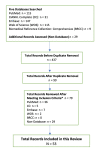The Breast Edema Enigma: Features, Diagnosis, Treatment, and Recommendations
- PMID: 35518543
- PMCID: PMC9065943
- DOI: 10.7759/cureus.23797
The Breast Edema Enigma: Features, Diagnosis, Treatment, and Recommendations
Abstract
Breast edema most commonly occurs after breast cancer treatment involving breast-conserving therapy, although it may have a variety of other causes. As compared to research on breast cancer treatment-related lymphedema, breast edema and its objective measurement and diagnosis is far behind. Consequences of this disparity contribute to uncertainty and variability in its diagnosis, its treatment, and even the characterization of its incidence and morbidity. Moreover, consensus on a standardized definition, objective diagnostic method, and treatment techniques for breast edema has not yet been reached, making it difficult to provide appropriate guidelines with respect to its management. Given the recent rise in breast edema incidence as an outcome of the increasing use of breast-conserving therapy, this timely review examines the current state of breast edema assessment and makes a case for standardization in part via quantitative methods to diagnose and track breast edema.
Keywords: breast cancer; breast edema; breast lymphedema; breast-conserving therapy; diagnostic recommendations; guidelines; tissue dielectric constant.
Copyright © 2022, Gupta et al.
Conflict of interest statement
The authors have declared that no competing interests exist.
Figures
Similar articles
-
Breast edema, from diagnosis to treatment: state of the art.Arch Physiother. 2021 Mar 29;11(1):8. doi: 10.1186/s40945-021-00103-4. Arch Physiother. 2021. PMID: 33775252 Free PMC article.
-
Lymphedema of the operated and irradiated breast in breast cancer patients following breast conserving surgery and radiotherapy.Lymphology. 2012 Dec;45(4):154-64. Lymphology. 2012. PMID: 23700762
-
Arm edema in breast cancer patients.J Natl Cancer Inst. 2001 Jan 17;93(2):96-111. doi: 10.1093/jnci/93.2.96. J Natl Cancer Inst. 2001. PMID: 11208879 Review.
-
The future of Cochrane Neonatal.Early Hum Dev. 2020 Nov;150:105191. doi: 10.1016/j.earlhumdev.2020.105191. Epub 2020 Sep 12. Early Hum Dev. 2020. PMID: 33036834
-
Breast radiotherapy and lymphedema.Cancer. 1998 Dec 15;83(12 Suppl American):2788-97. doi: 10.1002/(sici)1097-0142(19981215)83:12b+<2788::aid-cncr27>3.3.co;2-9. Cancer. 1998. PMID: 9874399 Review.
Cited by
-
XGBoost Enhances the Performance of SAFE: A Novel Microwave Imaging System for Early Detection of Malignant Breast Cancer.Cancers (Basel). 2025 Jan 10;17(2):214. doi: 10.3390/cancers17020214. Cancers (Basel). 2025. PMID: 39857996 Free PMC article.
-
Medical Applications of Skin Tissue Dielectric Constant Measurements.Cureus. 2023 Dec 14;15(12):e50531. doi: 10.7759/cureus.50531. eCollection 2023 Dec. Cureus. 2023. PMID: 38222165 Free PMC article. Review.
-
Breast Lymphedema Secondary to Lymph Node Tuberculosis: Case Report.Eur J Breast Health. 2025 Jun 20;21(3):274-276. doi: 10.4274/ejbh.galenos.2025.2025-4-3. Epub 2025 May 27. Eur J Breast Health. 2025. PMID: 40421493 Free PMC article.
-
Breast Cancer-Related Lymphedema Assessed via Tissue Dielectric Constant Measurements.Cureus. 2024 Apr 29;16(4):e59261. doi: 10.7759/cureus.59261. eCollection 2024 Apr. Cureus. 2024. PMID: 38813316 Free PMC article. Review.
-
Breast lymphedema following breast-conserving treatment for breast cancer: current status and future directions.Breast Cancer Res Treat. 2024 Apr;204(2):193-222. doi: 10.1007/s10549-023-07161-1. Epub 2023 Dec 15. Breast Cancer Res Treat. 2024. PMID: 38100015 Review.
References
-
- Breast edema in patients treated conservatively for stage I and II breast cancer. Pezner RD, Patterson MP, Hill LR, Desai KR, Vora N, Lipsett JA. Int J Radiat Oncol Biol Phys. 1985;11:1765–1768. - PubMed
-
- Lymphedema following breast cancer treatment and impact on quality of life: a review. Taghian NR, Miller CL, Jammallo LS, O'Toole J, Skolny MN. Crit Rev Oncol Hematol. 2014;92:227–234. - PubMed
-
- Identification, assessment and management of breast oedema after treatment for cancer. Todd M. Int J Palliat Nurs. 2017;23:440–444. - PubMed
Publication types
LinkOut - more resources
Full Text Sources
Research Materials
Miscellaneous

